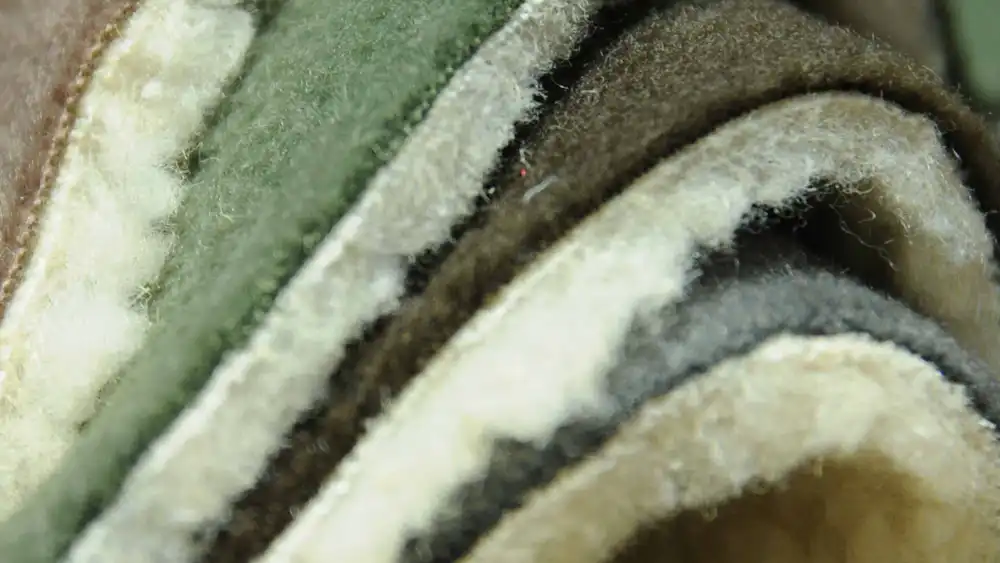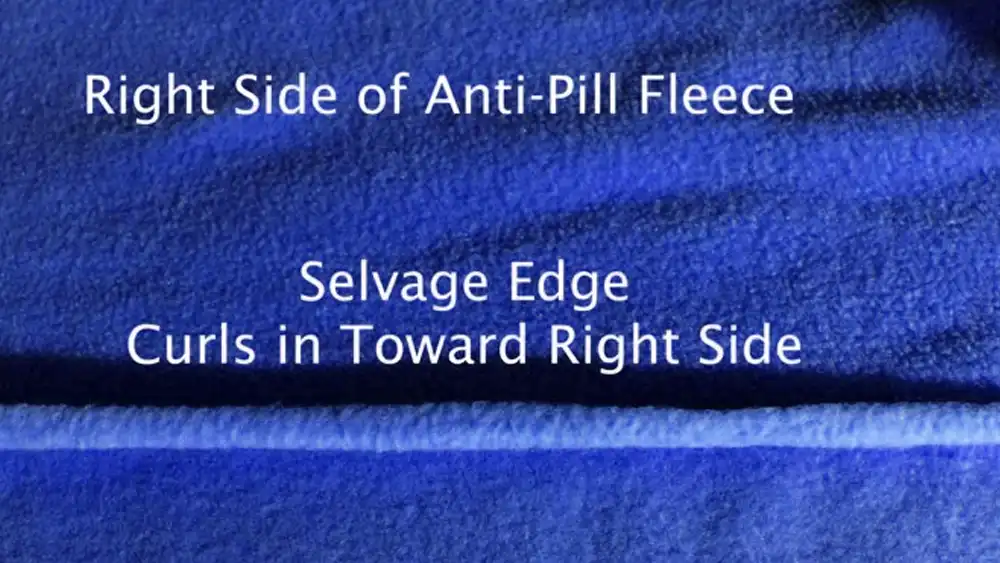You can easily learn how to tell the right side of fleece fabric, even if you’re new to sewing. Try this: gently pull the fabric along the cross-grain edge and watch the curl.
The right side will curl toward itself. Using the correct side makes your projects look and feel better. Many crafters share that this simple trick saves time and avoids mistakes. F&A’s fleece stands out for its soft texture and vibrant finish, thanks to its focus on quality and innovation.
Key Takeaways
- Feel the fabric to find the softer, longer fibers on the right side for a smooth, plush touch.
- Cut a small strip and pull it gently; the right side curls inward along the edge.
- Look for shine and nap by holding the fabric to light; the right side shines and feels smooth.
- Use clips or washable markers to mark the right side and keep your project organized.
- Always keep all pieces facing the right side up to ensure a neat, professional finish.
How to Tell the Right Side of Fleece Fabric?

When you pick up a piece of fleece, you might wonder how to tell the right side of fleece fabric. Don’t worry—there are a few simple tricks you can use. Let’s break down the most effective ways so you can feel confident every time you sew or craft.
Check Fiber Length and Texture
Start by running your fingers across both sides of the fleece. The right side usually feels softer and more plush. You’ll notice the fibers are longer and the surface feels extra smooth. This isn’t just a guess—scientific studies show that measuring fiber length and texture gives a reliable clue about fleece quality.
For example, researchers used advanced tools to measure fiber counts and lengths in different fabrics. They found that these measurements could predict how the fabric would look and feel. Longer, finer fibers create a smoother, more luxurious surface, which is exactly what you want on the outside of your project.
Tip: F&A’s fleece stands out because of its carefully controlled fiber length and texture. You’ll notice the difference right away when you touch their fabric.
Observe Curl Direction on Cut Edge
Here’s a classic trick for how to tell the right side of fleece fabric: look at the edge after you cut it. Gently pull the fabric along the cross-grain. The right side will curl toward itself. This method works because of the way the fibers are knitted or woven.
Studies show that curl direction is a highly accurate way to identify fabric sides. In fact, tests found that the error margin for this method is less than 0.1%, and the results stay consistent over time. So, if you see the edge curling in, you’ve probably found the right side.
- Quick Steps:
- Cut a small strip from your fleece.
- Pull the strip gently along the width.
- Watch which way the edge curls—the right side curls inward.
Look for Shine and Nap
Another easy way to figure out how to tell the right side of fleece fabric is to check for shine and nap. Hold the fabric up to the light. The right side often looks a bit shinier and reflects light more evenly.
You’ll also notice the nap, which is the direction the fibers naturally lay. When you brush your hand over the right side, it feels smooth, and the color may look richer. The wrong side usually looks duller and feels a bit rougher.
If you use F&A’s fleece, you’ll see a beautiful, even shine and a soft nap on the right side. Their advanced manufacturing process ensures both sides look great, but the right side always stands out with its smooth finish.
When you combine these methods—fiber length and texture, curl direction, and shine—you’ll always know how to tell the right side of fleece fabric. Try them out on your next project and see how much easier it gets!
Why the Right Side of Fleece Fabric Matters

Appearance and Finish
When you use the right side of fleece, your project instantly looks more polished. The colors appear brighter, and the surface has a clean, even look. If you want your blanket, hoodie, or plush toy to stand out, always check for the right side before you start sewing.
The right side often shows off the fabric’s best features, like a rich color and a soft shine. You might notice that seams look neater and edges appear more professional.
Note: F&A’s fleece fabrics go through advanced treatments that boost color and texture. This means both sides look great, but the right side really shines with a vibrant finish.
Here’s a quick checklist for appearance:
- Brighter color
- Even surface
- Neat seams
- Professional look
Comfort and Function
The right side of fleece doesn’t just look good—it feels better, too. When you touch the right side, you’ll notice it feels extra soft and smooth.
This makes a big difference for anything that touches your skin, like scarves, hats, or baby blankets. The right side also helps your project last longer. It resists pilling and keeps its shape after washing.
If you use F&A’s fleece, you get a fabric that feels gentle and stays comfortable over time. Their focus on quality means you can trust both sides, but the right side always gives you the best experience.
- Soft touch for comfort
- Durable for everyday use
- Keeps its shape and color
Choosing the right side of fleece helps you create projects that look amazing and feel great. You’ll notice the difference every time you use your finished piece.
Identifying Different Types of Fleece

Standard Fleece
When you pick up standard fleece, you notice its soft, cozy feel right away. This type of fleece is popular for blankets, sweatshirts, and jackets. You might wonder how it compares to other fabrics in terms of warmth and quality. Here are some key points that set standard fleece apart:
- Standard fleece insulation is measured by R-value and clo, which tell you how well it keeps you warm.
- Fleece has a lower warmth-to-weight ratio than other insulations like batt or knit types. For example, fleece averages about 0.09 clo/oz/yd², while batt insulations can reach 0.42 clo/oz/yd².
- Heavier fleece does not always mean warmer fleece. Sometimes, lighter fleece performs better in insulation tests.
- Product names like “100 weight” or “300 weight” do not always match up with actual warmth, so it’s best to check real performance data.
You can also look at fiber test results to judge quality. Experts measure things like fiber diameter and uniformity to make sure the fleece feels soft and lasts a long time. These measurements help producers select the best fleece for comfort and durability.
Anti-Pill Fleece
If you want your projects to look new after many washes, anti-pill fleece is a great choice. This fabric resists those annoying little balls, or “pills,” that can form on the surface. You can count on anti-pill fleece for both comfort and long-lasting beauty.
| Feature | Anti-Pill Fleece Value |
|---|---|
| Thermal Resistance | 0.20–0.35 clo |
| Durability | High (tested by repeated washing) |
| Pilling Resistance | Excellent |
| Stretch & Recovery | Good, especially with spandex |
Manufacturers test anti-pill fleece for durability by running it through many laundry cycles. They also check how well it bounces back after stretching. These tests help you choose a fleece that stays soft and smooth, even after lots of use.
Blizzard and Double-Sided Fleece
Blizzard fleece and double-sided microfleece each offer something special. You might choose Blizzard fleece for its plush, velvety finish and extra warmth. Double-sided microfleece feels soft on both sides and works well for activewear or home textiles.
| Fabric Type | Blizzard Fleece | Double-Sided Microfleece |
|---|---|---|
| Texture | Plush, velvety | Extra soft, brushed on both sides |
| Weight | Slightly heavier | Lightweight |
| Insulation | High | Warm, but lighter |
| Durability | Anti-pilling | Durable, easy to wash |
| Best Uses | Crafts, blankets, cozy wear | Activewear, outdoor, home décor |
Tip: If you want a fleece that feels luxurious and keeps you warm, try blizzard fleece. For something lightweight and easy to care for, double-sided microfleece is a smart pick.
Tips for Marking and Tracking the Right Side
Use Clips or Washable Markers
You want to keep track of the right side of your fleece as you work. This step saves you from confusion later. One of the easiest ways is to use sewing clips. Just attach a bright clip to the right side of each piece as soon as you cut it. The clip acts as a quick visual reminder. You can move it around as you sew, so you never lose track.
Washable fabric markers also work well. Draw a small “X” or a dot on the edge of the right side. Pick a spot that will end up in the seam or get trimmed away. That way, the mark won’t show on your finished project. These markers wash out easily, so you don’t have to worry about stains.
Tip: Always test your marker on a scrap of fleece first. Some colors show up better than others, especially on darker fabrics.
Here are some marketing ideas:
- Use different colored clips for each project.
- Try sticky notes if you don’t have clips or markers.
- Place a safety pin on the right side for a quick fix.
Keep Sides Consistent
You want every piece of your project to face the same way. Mixing up the sides can lead to uneven color or texture. Before you start sewing, lay out all your pieces with the right side up. Double-check each one. This habit helps you avoid mistakes and keeps your project looking professional.
If you work with lots of pieces, stack them with the right side facing up. You can even label your pattern pieces with “RS” (right side) and “WS” (wrong side) using sticky notes or tape.
Note: F&A’s fleece makes this step easier because the right side stands out with its soft shine and smooth feel.
Stay organized, and you’ll breeze through your project with confidence!
Conclusion
You now know how to spot the right side of fleece fabric. Try these steps with your own fabric, especially F&A’s soft, high-quality fleece. Here’s a quick checklist to help you remember:
- Feel for the softer, longer fibers
- Watch the curl on the cut edge
- Check for shine and nap
Practice makes perfect! Trust your hands and eyes. You’ve got this—your next project will look and feel amazing.
FAQ
How do I tell the right side of printed fleece?
Printed fleece usually has the design brighter and clearer on the right side. The wrong side looks faded or less detailed. If you use F&A’s printed fleece, you’ll notice the colors pop more on the right side.
Can I use both sides of fleece for my project?
You can use both sides if you like the look and feel. Many crafters prefer the right side for its softness and shine. F&A’s fleece feels great on both sides, so you have options.
Will washing fleece change the right side?
Washing fleece does not change the right side. The texture and shine stay the same, especially with high-quality fleece like F&A’s. Always follow care instructions for best results.
What if I mix up the sides while sewing?
Don’t worry! Your project will still work, but the finish may look uneven. Try using clips or markers to keep track. This simple step saves time and helps your project look polished.
Does anti-pill fleece have a different right side?
Anti-pill fleece has a right side that feels smoother and resists pilling. The wrong side may feel less soft. You’ll notice the difference when you touch both sides, especially with F&A’s anti-pill options.
